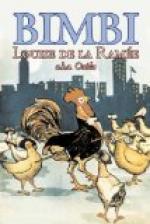No doubt the good folks of Urbino laughed at him often for a little moonstruck dreamer, so many hours did he stand looking, looking,—only looking,—as eyes have a right to do that see well and not altogether as others see. Happily for him, the days of his childhood were times of peace, and he did not behold, as his father had done, the torches light up the street and the flames devour the homesteads.
At this time Urbino was growing into fame for its pottery work: those big dishes and bowls, those marriage plates and pharmacy jars which it made, were beginning to rival the products of its neighbor Gubbio, and when its duke wished to send a bridal gift, or a present on other festal occasions, he oftenest chose some service or some rare platter of his own Urbino ware. Now, pottery had not then taken the high place among the arts of Italy that it was destined very soon to do. As you will learn when you are older, after the Greeks and the Christians had exhausted all that was beautiful in shape and substance of clay vases, the art seemed to die out, and the potters and the pottery painters died with it, or at any rate went to sleep for a great many centuries, whilst soldiers and prelates, nobles and mercenaries, were trampling to and fro all over the land and disputing it, and carrying fire and torch, steel and desolation, with them in their quarrels and covetousness. But now, the reign of the late good duke, great Federigo, having been favorable to the Marches (as we call his province now), the potters and pottery painters, with other gentle craftsmen, had begun to look up again, and the beneficent fires of their humble ovens had begun to burn in Castel Durante, in Pesaro, in Faenza, in Gubbio, and in Urbino itself. The great days had not yet come: Maestro Giorgio was but a youngster, and Orazio Fontane not born, nor the clever baker Prestino either, nor the famous Fra Xanto; but there was a Don Giorgio even then in Gubbio, of whose work, alas! one plate now at the Louvre is all we have; and here in the ducal city on the hill rich and noble things were already being made in the stout and lustrous majolica that was destined to acquire later on so wide a ceramic fame. Jars and bowls and platters, oval dishes and ewers and basins, and big-bodied, metal-welded pharmacy vases were all made and painted at Urbino whilst Raffaelle Sanzio was running about on rosy infantine feet. There was a master-potter of the Montefeltro at that time, one Maestro Benedetto Ronconi, whose name had not become world-renowned as Orazio Fontane’s and Maestro Giorgio’s did in the following century, yet who in that day enjoyed the honor of all the duchy, and did things very rare and fine in the Urbino ware. He lived within a stone’s throw of Giovanni Sanzio, and was a gray-haired, handsome, somewhat stern and pompous man, now more than middle-aged, who had one beauteous daughter, by name Pacifica. He cherished Pacifica well, but not so well as he cherished the things he




